I have been running alternate firmware on my Linksys routers for years now. I only buy Linksys routers to the point that I check compatibility before the purchase of a new one. I realize you can use a various amount of different routers, I just have had great luck with Linksys. I have suffered with slow bandwidth around the house to accommodate for all my portable devices that only supports Wireless-G. Here I will show you that you can make a full scale 300mbps wireless topology while adhering to the legacy devices.
To understand my setup, I will outline what all I have and use it for.
Computer room:
This is where the DSL comes in the house.
Main Router: Linksys E3000 – Firmware dd-wrt e2000-3000-big 192.168.1.1
Computer direct connected running Windows Media server
Living room:
Secondary Router: Linksys E2000 (upgraded from WRT310 for 5Ghz option spectrum) 192.168.1.2
Direct TV HR24 DVR with Whole House DVR
PS3 – DLNA Media Streaming Server
Onkyo TX-NR5007
Bedroom:
Tertiary Router: Linksys E2000 (also upgraded from 310) 192.168.1.2
Direct TV HR24 WHDVR
Samsung Flatscreen with DNLA capable – pretty crappy if I may say so though.
**Also, lets not forget that I use a laptop, iPad and have android phones in the house. The iPad has Wireless-N, but the phones will utilize the G, so I need something that can be backwards compatible. Remember, in wireless…If you have something running on a G band, even though it is on an N network this will bring everyone down to G level speeds. This is where the fun of the Linksys E3000 and it’s dual bands for 2 SSID’s come in. 🙂
Now here is why I need all the routers. Most of the items on these lists only use Ethernet. And I don’t understand why they think you are going to run Ethernet all over your house. I had no plans in doing that at all. So to get around all that, I bought three routers and made two of them Client Bridges. I recommend this plan if you intend to use a 720p to 1080p media stream capabilities. You can do it with G transmitting at 54 Mbps, but expect choppy and lag when intense explosions render extra bandwidth needs. This will give the maximum bandwidth to about 30 Mbps when you will require much more for High Def streaming. For example, 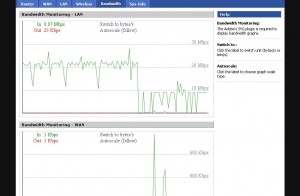 here you can see that my limitations have been met while streaming “The Social Network” from my pc to the PS3. As you can see it works fine because the movie doesn’t really have a lot of action and looks great at 720p. But lets say you want to get an action movie and it is in 1080p. There would be no way to watch it at some points. Fast forwarding and rewinding these types of movies are totally out of the question because of lag. Also, the PS3 uses a wireless-G card, so we have to take that out of the mix. To do that we put a Wireless Client Bridge with N-Only capabilities in front of it. The end result will give you astonishing bandwidth to multiple rooms being able to rewind and fast forward digital movies with ease. Streaming media players are only getting more popular with the use of Netflix. However, even though I subscribe to them I wish their quality was better.
here you can see that my limitations have been met while streaming “The Social Network” from my pc to the PS3. As you can see it works fine because the movie doesn’t really have a lot of action and looks great at 720p. But lets say you want to get an action movie and it is in 1080p. There would be no way to watch it at some points. Fast forwarding and rewinding these types of movies are totally out of the question because of lag. Also, the PS3 uses a wireless-G card, so we have to take that out of the mix. To do that we put a Wireless Client Bridge with N-Only capabilities in front of it. The end result will give you astonishing bandwidth to multiple rooms being able to rewind and fast forward digital movies with ease. Streaming media players are only getting more popular with the use of Netflix. However, even though I subscribe to them I wish their quality was better.
Off to the installation…
I am not going through the flashing and learning of the interface. I trust that the people interested will utilize their WIKI’s for each individual supported router. http://www.dd-wrt.com/site/index. The site has great information about setup do’s and don’ts.
E3000
Here is my configuration for the Wireless Lan 0 (wl0)
We are going to need this for the cell phones, guests or basically anyone who’s device cannot see N routers on a 5GHz spectrum. There are more devices than you think. As I sit here typing on my crappy Lenovo laptop that has wireless N, but cannot see 5GHz. Only 2.4.
Next we will configure the 5GHz only spectrum on the primary router.
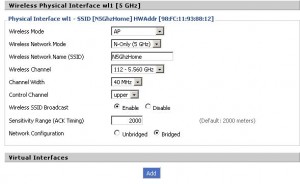 Here I configured the secondary SSID Access Point for N-only. I chose a specific channel off of what I read on a forum as a guideline. I just didn’t want it set to Auto. Then I changed the Channel Width to 40.
Here I configured the secondary SSID Access Point for N-only. I chose a specific channel off of what I read on a forum as a guideline. I just didn’t want it set to Auto. Then I changed the Channel Width to 40.
Now we save those changes and setup the Client Bridges. Assuming you know how to configure your router with IP, PPOE and all the other necessary information for your DSL\Cable.
Client Bridge 1
Now the client bridge needs to be setup. I recommend you save the setting as you switch pages so you don’t keep having to restart the router. Also, clicking apply once you set the router to a client bridge seals the deal. So if there is a mistake, you will have to hard reset the router. This isn’t uncommon for getting multiple routers hooked up. I must have had to reset one of the at least 2 times each thinking I was done. 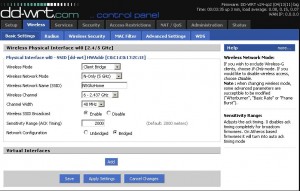 Setting up the client bridge is the easiest part. Just really 3 steps.
Setting up the client bridge is the easiest part. Just really 3 steps.
1) Assign it an IP that is in range with your primary router (ie 192.168.1.2)
2) Give the settings i listed in the picture.
3) Assign the same security that you gave the primary router with the 5GHz channel including the same password.
Hit apply and jump on your network and ping the 192.168.1.2 until it responds. If you don’t receive something within a minute, big chances that a reset of the secondary router is in your future. Start over and try it again. Once the routers are communicating you can go into the main router and look at the clients. From here on out you can add as many wireless client bridges as you would like. Just give them different names and ip’s. This turned my Wireless-G PS3 into a 5GHz N only ultra media player. Ok, I really just wanted to use the word ultra for my home theater setup. Below is the bandwidth after I added the Wireless-N only 5GHz only prepared at going 300 mpbs.
Enjoy!
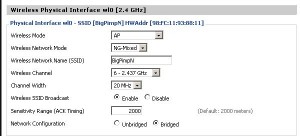
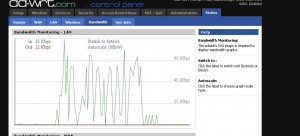

No Responses (yet)
Stay in touch with the conversation, subscribe to the RSS feed for comments on this post.